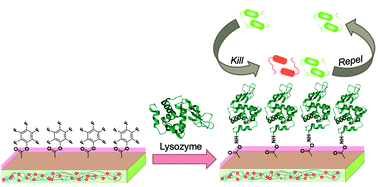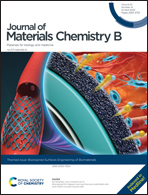Surfaces with antifouling-antimicrobial dual function via immobilization of lysozyme on zwitterionic polymer thin films†
Abstract
Due to the emergence of wide-spread infectious diseases, there is a heightened need for antimicrobial and/or antifouling coatings that can be used to prevent infection and transmission in a variety of applications, ranging from healthcare devices to public facilities. While antimicrobial coatings kill pathogenic bacteria upon contact with the surface, the antimicrobial function alone often lacks long-term effectiveness due to the accumulation of dead cells and their debris on the surface, thus reducing the performance of the coating over time. Therefore, it is desirable to develop coatings with the dual functions of antimicrobial efficacy and fouling resistance, in which antifouling coatings provide the added benefit of preventing the adhesion of dead cells and debris. Leveraging the outstanding antifouling properties of zwitterionic coatings, we synthesized copolymers with this antimicrobial-antifouling dual function by immobilizing lysozyme, a common antimicrobial enzyme, to the surface of a pyridinium-based zwitterionic copolymer. Specifically, poly(4-vinylpyridine-co-pentaflurophenyl methacrylate-co-divinyl benzene) [P(4VP-PFPMA-DVB)] thin films were synthesized by an all-dry vapor deposition technique, initiated Chemical Vapor Deposition, and derivatized using 1,3-propane sultone to obtain sulfobetaine moieties. Lysozyme, known to hydrolyze polysaccharides in the cell wall of Gram-positive bacteria, was immobilized by forming amide bonds with the copolymer coating via nucleophilic substitution of the pentafluorophenyl group. The antifouling and antibacterial performance of the novel lysozyme-zwitterionic coating was tested against Gram-positive Bacillus subtilis and Gram-negative Pseudomonas aeruginosa. A reduction in surface adhesion of 87% was achieved for P. aeruginosa, and of 75% for B. subtilis, when compared to a common poly(vinyl chloride) surface. The lysozyme-zwitterionic coating also deactivated 67% of surface-attached Gram-positive bacteria, B. subtilis. This novel dual-function material can produce anti-infection surfaces for medical devices and surgical tools, personal care products, and surfaces in public facilities.

- This article is part of the themed collections: Celebrating International Women’s Day: Women in Materials Science, 10th Anniversary: Dedicated Authors, 10th Anniversary: Most popular articles, 2022 Journal of Materials Chemistry B Most Popular Articles and Bioinspired Surfaces Engineering for Biomaterials


 Please wait while we load your content...
Please wait while we load your content...
